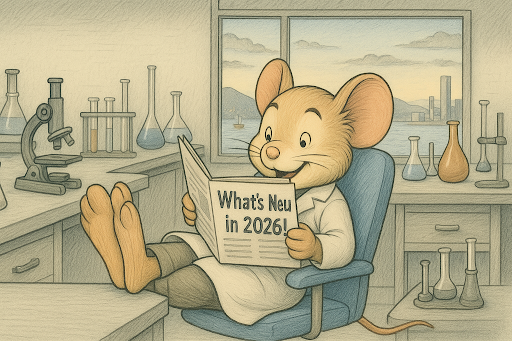Emerging Trends Shaping In Vivo Animal Studies in 2026

In vivo animal studies are essential for drug discovery and development, bridging cellular assays and human applications1,2. Significant progress is underway in creating new animal models that better reflect diseases, paving the way for promising new therapies in the near future3,4. However, preclinical researchers and organizations can only use new developments if they remain engaged with the latest trends. In 2026, there will likely be an increased focus on integrating more ethical practices when using animals in research. Central to this shift is the 3Rs principle (Replacement, Reduction, Refinement)5. Another development making waves into 2026 is that the FDA Modernization Act no longer requires in vivo animal studies and testing for drug approvals6,7. This is a positive step for animal welfare and emphasizes opportunities for growth in areas like in silico approaches.
In this blog, we’ll give you a quick rundown of the top trends to keep in mind as we move into the new year.
1. Cutting Down on Animal Waste
Minimizing animal waste is becoming a priority in preclinical research as laboratories adopt more rigorous protocols for handling biological materials and research byproducts. Institutional animal care and use committees (IACUCs) are increasingly requiring comprehensive waste management plans that align with sustainability goals and the 3Rs principle5. Advanced segregation systems and improved disposal methods not only reduce environmental impact but also demonstrate institutional commitment to responsible animal research practices. By implementing standardized protocols for experiments, tissue collection, biobanking, and material reuse, researchers can extract maximum scientific value from each in vivo study while demonstrating ethical stewardship and reducing overall research costs.
2. Integration of NAMs
New Approach Methodologies (NAMs) represent a transformative shift in preclinical research, encompassing innovative technologies including in vitro assays, organoid systems, organ-on-chip models, and artificial intelligence-driven computational approaches that can evaluate drug safety and efficacy without relying solely on traditional animal testing. The FDA and NIH have issued guidance emphasizing the adoption of NAMs as a cornerstone of modern drug development, with the FDA's Roadmap to Reducing Animal Testing targeting increased NAM adoption within 3-5 years6. By focusing on human-relevant biology, NAMs offer the potential to deliver more accurate predictions of human safety outcomes while directly supporting the 3Rs principle through replacement, reduction, and refinement of animal use.
Rather than attempting a wholesale replacement of animal studies, the industry is moving through a strategic, phased approach where NAMs are deployed alongside existing in vivo studies to build robust evidence packages. Companies are already encouraged to submit NAM data alongside traditional animal data to regulatory agencies, creating a growing repository of comparative evidence that will inform future decisions about which studies can be conducted using non-animal methods alone. As regulatory frameworks continue to evolve in 2026, organizations that proactively integrate NAMs into their preclinical strategies will gain competitive advantage while advancing both scientific rigor and animal welfare.

3. Advanced Imaging and Biomarker Implementation
Improved imaging and monitoring technologies allow researchers to generate more data from animal models and gain more insights into the pathophysiology and progression of different diseases16. Significant advances are being made in neuroimaging techniques for brain studies, enabling better modeling of conditions like Alzheimer’s disease and autism17. Wearable sensors for animals give researchers greater insights into the impact of disease on animal physiology during progression18. Monitoring systems are also valuable for tracking animal well-being and identifying underlying issues that may compromise animal welfare and affect the quality of experimental results. Advanced molecular imaging probes allow scientists to more precisely assess the effect of therapeutic interventions, track disease biomarkers, and visualize molecular pathways in real-time19–21.

4. Demonstrating Clinical Relevance
Translating findings from animal models to successful human therapies remains a central challenge in drug development. In 2026, researchers are increasingly focusing on selecting and designing in vivo studies that more accurately predict human clinical outcomes. This involves choosing animal models that closely mirror human disease pathology, incorporating human-relevant dosing strategies, and utilizing biomarkers that correlate with clinical endpoints. By emphasizing clinical relevance from the outset, researchers can reduce late-stage development failures and improve the probability of regulatory approval. Advanced phenotyping, humanized animal models, and comparative analysis across species are enabling more robust translation of preclinical findings to the clinic, ultimately accelerating time-to-market for promising new therapeutics.
Future Proof Your In Vivo Animal Studies and Experimental Design with ModernVivo
ModernVivo is ahead of the curve in providing AI-driven literature reviews for in vivo animal studies and design. Many researchers from top institutions are using ModernVivo today to reap the benefits of higher-quality and compliant animal study design in 2026. Today, the only certainty is that advancements will accelerate, requiring researchers to stay actively informed about the latest trends and published research experimental designs and outcomes.
Step Confidently into 2026 with ModernVivo
ModernVivo is already providing in vivo researchers with the next-level tools they need to gain an advantage in 2026. Contact our team to schedule a demo today!
References
1. Chang MCJ, Grieder FB. The continued importance of animals in biomedical research. Lab Anim. 2024;53(11):295-297.
2. Domínguez-Oliva A, Hernández-Ávalos I, Martínez-Burnes J, Olmos-Hernández A, Verduzco-Mendoza A, Mota-Rojas D. The Importance of Animal Models in Biomedical Research: Current Insights and Applications. Animals (Basel). 2023;13(7):1223.
3. Sadler KE, Mogil JS, Stucky CL. Innovations and advances in modeling and measuring pain in animals. Nat Rev Neurosci. 2022;23(2):70-85.
4. He S, Ru Q, Chen L, Xu G, Wu Y. Advances in animal models of Parkinson’s disease. Brain Research Bulletin. 2024;215:111024.
5. The 3Rs | NC3Rs. Accessed December 5, 2024.
6. Zushin PJH, Mukherjee S, Wu JC. FDA Modernization Act 2.0: transitioning beyond animal models with human cells, organoids, and AI/ML-based approaches. J Clin Invest. 2023;133(21):e175824.
7. Animal research is not always king: researchers should explore the alternatives. Nature. 2024;631(8021):481-481.
8. Madden JC, Enoch SJ, Paini A, Cronin MTD. A Review of In Silico Tools as Alternatives to Animal Testing: Principles, Resources and Applications. Altern Lab Anim. 2020;48(4):146-172.
9. Barh D, Yiannakopoulou ECh, Salawu EO, et al. In silico disease model: from simple networks to complex diseases. In: Animal Biotechnology. Elsevier; 2020:441-460.
10. Boitet M, Achek A, Bouchenaki K, Grailhe R. BrightMice: a low-cost do-it-yourself instrument, designed for in vivo fluorescence mouse imaging. Sci Rep. 2024;14(1):22685.
11. Markicevic M, Savvateev I, Grimm C, Zerbi V. Emerging imaging methods to study whole-brain function in rodent models. Transl Psychiatry. 2021;11(1):457.
12. Zhou J, Zhou S, Fan P, et al. Implantable Electrochemical Microsensors for In Vivo Monitoring of Animal Physiological Information. Nanomicro Lett. 2023;16(1):49.
13. He H, Zhang X, Du L, et al. Molecular imaging nanoprobes for theranostic applications. Advanced Drug Delivery Reviews. 2022;186:114320.
14. Kim SJ, Lee HY. In vivo molecular imaging in preclinical research. Lab Anim Res. 2022;38(1):31.
15. Geng Y, Wang Z, Zhou J, Zhu M, Liu J, James TD. Recent progress in the development of fluorescent probes for imaging pathological oxidative stress. Chem Soc Rev. 2023;52(11):3873-3926.
16. Huang ETC, Yang JS, Liao KYK, et al. Predicting blood–brain barrier permeability of molecules with a large language model and machine learning. Sci Rep. 2024;14(1):15844.
17. Carey H, Pegios M, Martin L, et al. DeepSlice: rapid fully automatic registration of mouse brain imaging to a volumetric atlas. Nat Commun. 2023;14(1):5884.
18. Dong Z, Jiang W, Wu C, et al. Spatial proteomics of single cells and organelles on tissue slides using filter-aided expansion proteomics. Nat Commun. 2024;15(1):9378.
19. Ahmed Z, Wan S, Zhang F, Zhong W. Artificial intelligence for omics data analysis. BMC Methods. 2024;1(1):4, s44330-024-00004-00005.


.png)
.png)
.avif)
